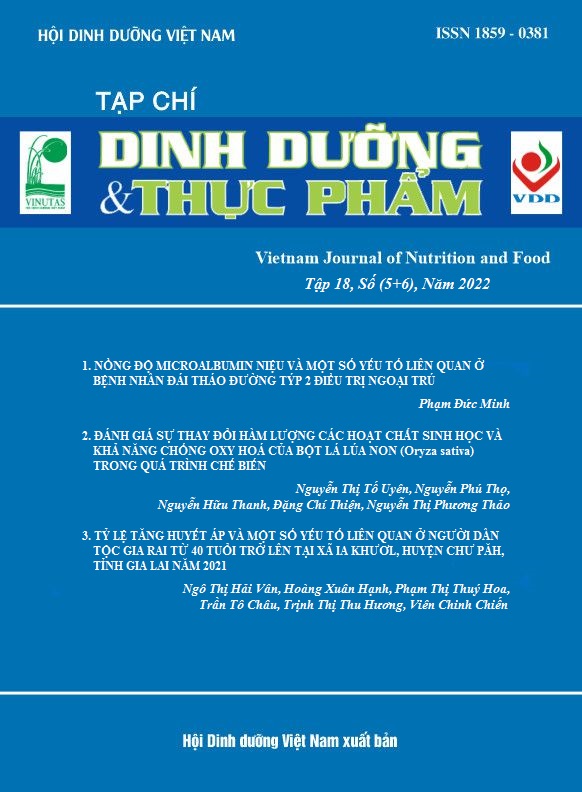SURVEYING SOME FACTORS AFFECTING THE QUALITY OF 𝘉𝘈𝘊𝘊𝘈𝘜𝘙𝘌𝘈 𝘚𝘈𝘗𝘐𝘋𝘈 JUICE
Main Article Content
Abstract
Aims: Baccaurea sapida contain many valuable nutritional components, which are beneficial to human health. The purpose of the study is to investigate some factors affecting the technological process of processing Baccaurea sapida juice, creating products with high nutritional and sensory values, meeting the needs of consumers.
Methods: Research on processing Baccaurea sapida juice was carried out on the basis of investigating the influence of pectinase and ellulase; hydrolysis temperature and time; dilution ratio of hydrolysate and stevia syrup; pasteurization. Experiment were repeated 3 times, statistical data, graphing using software Statgraphic centurion XV and SigmaPlot-14.0.
Results: Experimental results showed that: hydrolyzed the peel and flesh of Baccaurea sapida with the ratio of 0.4% pectinase and hemicellulase enzymes 0.6% at 550C for 40 minutes; Hydrolyzed fruit juice was diluted in a ratio of 1/4, supplemented with 25% stevia syrup and pasteurization at 90oC for 25 minutes. The obtained Baccaurea sapida juice has vitamin C content reached 49.07mg%; total acid content reached 1.71%; chlorophyll content reached 0.424µg/L.
Conclusion: Baccaurea sapida juice product is created by performing the process of hydrolyzing the skin and flesh of fruit along with the addition of water, stevia syrup and pasteurization.
Keywords
Baccaurea sapida, hydrolysis, mixing, pasteurization
Article Details
References
2. Tapre AR and Jain RK. Pectinases: Enzymes for fruit processing industry. International Food Research Journal. 2014;21(2):447-453
3. Nguyễn Nhật Minh Phương, Lý Nguyễn Bình, Châu Trần Diễm Ái và Chế Văn Hoàng. Tác động enzyme pectinase đến khả năng trích ly dịch quả và các điều kiện lên men đến chất lượng rượu vang xoài sau thời gian lên men chính. Tạp chí Khoa học Trường Đại học Cần Thơ. 2011;20(a):127-136.
4. Sharma HP, Patel H, and Sharma S. Enzymatic extraction and clarification of juice from various fruits: A Review. Trends in Post Harvest Technology.2014;2(1):1-14.
5. Cacace JE and Mazza G. Mass transfer process during extraction of phenolic compounds from milled berries. Food and Engineering. 2003;59:379–389.
6. Gupta S, Lakshmi AJ, and Prakash J (2008). Effect of different blanching treatments on ascorbic acidretention in green vegetables. Natural Product Radiance. 2008;7(2):111-116.
7. Hà Duyên Tư. Phân tích hóa học thực phẩm. Nhà xuất bản Khoa học Kỹ thuật, 2009.
8. Jeney-Nagymate E, and Fodor P. The stability of vitamin C in different beverages. British Food Journal. 2008;110(3):296-309.
9. Nguyễn Thị Thu Hồng , Trần Minh Tuấn và Nguyễn Tấn Hùng. Ảnh hưởng của enzyme xử lý và chế độ thanh trùng đến chất lượng sản phẩm nước ép dưa. Tạp chí Khoa học Trường Đại học Cần Thơ. 2019;55: 241-249.
10. Lê Văn Việt Mẫn, Lại Quốc Đạt, Nguyễn Thị Hiền, Tôn Nữ Minh Nguyệt và Trần Thị Thu Trà. Công nghệ chế biến thực phẩm. Nhà xuất bản ĐHQG TP.HCM. 2009.
11. Vũ Hồng Sơn và Hà Duyên Tư. Nghiên cứu quá trình trích ly polyphenol từ chè xanh vụn. Tạp chí Khoa học Công nghệ. 2012;47(1):81-86.


